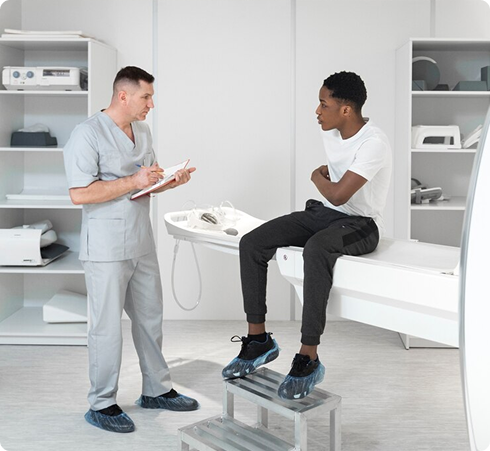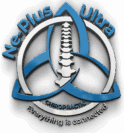Sciatica Symptoms and Treatment
Sciatica is a common condition characterized by pain that radiates along the path of the sciatic nerve, which branches from the lower back through the hips and buttocks and down each leg. This condition typically affects only one side of the body. It occurs when the sciatic nerve is compressed or irritated, often due to a herniated disc, bone spur, or spine narrowing (spinal stenosis).
At Ne-Plus Ultra Chiropractic in Pasadena, California, Dr. Lamar Baddley provides specialized care for sciatica that focuses on identifying and addressing the underlying causes of nerve compression rather than merely masking symptoms. With his extensive training and experience in treating nerve-related conditions, Dr. Baddley offers comprehensive, noninvasive approaches to sciatica relief and long-term prevention.

Common Types of
Knee Pain
Nerve Pathway
-
The sciatic nerve is the largest nerve in the body
-
Formed by ner ve roots emerging from the lumbar spine (L4 - S3)
-
Travels through the piriformis muscle in the buttock
-
Runs down the back of the thigh and branches into smaller nerves below the knee
-
Provides sensation and motor function to much of the lower body
Risk Factors
-
Age - related changes in the spine
-
Occupations requiring heavy lifting or prolonged sitting
-
Sedentary lifestyle
-
Obesity
-
Diabetes (increases risk of nerve damage)
-
Poor posture and body mechanics
-
Previous back injuries
Common Causes
-
Herniated or bulging discs in the lumbar spine
-
Degenerative disc disease
-
Spinal stenosis (narrowing of the spinal canal)
-
Piriformis syndrome (compression by the piriformis muscle)
-
Spondylolisthesis (slippage of one vertebra over another)
-
Trauma or injury to the lower back
-
Pregnancy (due to pressure on the sciatic nerve)
-
Muscle spasms or trigger points in the gluteal region

Common Symptoms
- Pain that radiates from the lower back through the buttock and down the leg
- Pain described as sharp, burning, shooting, or electric-like
- Numbness or tingling along the path of the sciatic nerve
- Muscle weakness in the affected leg or foot
- Pain that worsens with prolonged sitting, standing, or certain movements
- Difficulty walking or standing up straight
- Pain that may be constant or intermittent
- Symptoms typically affecting only one side of the body
- Increased pain with coughing, sneezing, or laughing
- Reduced reflexes in the affected leg (in some cases)
How Chiropractic Care
Addresses Addresses Sciatica
At Ne-Plus Ultra Chiropractic, Dr. Baddley takes a comprehensive approach to sciatica that addresses both the symptoms and the underlying causes of nerve compression. This approach is based on current best practices in chiropractic neurology and spine care.
Comprehensive Assessment
A thorough evaluation is essential for effective treatment of sciatica. Dr. Baddley’s assessment includes:
-
Detailed health history and symptom analysis
-
Comprehensive physical examination
-
Neurological testing including reflex, sensory, and muscle strength assessment
-
Orthopedic tests specific to sciatic nerve compression
-
Postural and gait analysis
-
Functional movement screening
-
Identification of contributing factors (work habits, lifestyle, etc.)
This multifaceted assessment allows Dr. Baddley to identify:
-
The specific source of nerve compression or irritation
-
The extent of nerve involvement
-
Biomechanical factors contributing to the condition
-
Movement patterns that may aggravate symptoms
-
Muscle imbalances or weaknesses
-
Postural abnormalities
-
Related areas of dysfunction
Personalized Treatment Approaches
Precise manipulations to address misalignments and restore proper function:
Based on your specific diagnosis, Dr. Baddley creates a personalized treatment plan that may include:
Spinal Adjustments
-
Specific lumbar and sacral adjustments to relieve pressure on nerve roots
-
Gentle techniques for acute or severe cases
-
Progressive care that adapts as symptoms improve
-
Diversified, drop table, or instrument - assisted adjustments based on individual needs
Posture Correction
Strategies to address postural issues that contribute to sciatic nerve pressure:
-
Ergonomic recommendations for work and daily activities
-
Postural awareness training
-
Corrective exercises for postural imbalances
-
Support devices when appropriate
Decompression Therapy
Non - surgical spinal decompression to relieve pressure on the sciatic nerve:
-
Gentle stretching of the spine to create negative pressure within discs
-
Promotion of retraction of herniated disc material
-
Improved nutrient exchange and healing environment
-
Progressive protocols based on response to treatment
-
Release of iliotibial band and related structures
-
Techniques to improve circulation and reduce inflammation
Lifestyle Modifications
Guidance on daily habits that impact sciatic nerve health
-
Proper lifting and bending techniques
-
Activity modification to reduce nerve irritation
-
Sleep positioning recommendations
-
Strategies to prevent recurrence
Soft Tissue Therapy
Targeted techniques to address muscle tension and trigger points:
-
Release of piriformis and other gluteal muscles that may compress the sciatic nerve
-
Myofascial release for tension in the lumbar region
-
Trigger point therapy for pain reduction
-
Deep tissue work to address chronic muscle patterns
Complementary Therapies
Additional modalities that enhance the effectiveness of chiropractic care:
-
Cold laser therapy to reduce inflammation around the nerve
-
Electrical stimulation for pain management
-
Ultrasound therapy to promote healing
-
Kinesio taping for support and pain reduction
Therapeutic Exercise
Customized exercise programs designed to:
-
Strengthen core and supp orting muscles
-
Improve flexibility in key muscle groups
-
Correct movement patterns that contribute to nerve compression
-
Enhance stability of the lumbar spine
-
Progressively rehabilitate the affected area
Evidence-Based Approach
Our treatment protocols are based on current research and clinical guidelines for sciatica management. Studies published in journals such as The Spine Journal and the Journal of
Manipulative and Physiological Therapeutics have demonstrated the effectiveness of chiropractic approaches for sciatica, showing improvements in pain reduction, functional
recovery, and quality of life measures compared to conventional medical care alone.

Expected Outcomes and
Benefits of Treatment
Patients who receive chiropractic care for back pain at Ne-Plus Ultra Chiropractic typically experience a range of positive outcomes:
Short-Term Benefits
-
Pain Reduction:
significant decrease in radiating leg pain
-
Decreased Inflammation
reduction in nerve irritation
-
Improved Mobility
increased ability to move without pai n
-
Better Sleep
Less pain interference with sleep quality
-
Reduced Medication Need
Less reliance on pain medications
Functional Improvements
-
Corrected Underlying Issues
Addressing the root causes of nerve compression
-
Improved Spinal Function
Better alignment and movement patterns
-
Enhanced Nerve Health
Reduced chronic irritation and sensitization
-
Preventive Strategies
tools and knowledge to prevent recurrence
-
Sustainable Self - Management
Skills to maintain sciatic nerve health
Quality of Life Improvements
-
Work Performance
Improved comfort and productivity at work
-
Daily Activities
Enhanced ability to perform routine tasks
-
Recreational Activities
Return to sports and hobbies
-
Quality of Life
Overall improvement in life satisfaction and well - being
-
Independence
Reduced need for ongoing treatment or assistance
Don’t let sciatic pain limit your life any longer. At Ne-Plus Ultra Chiropractic, Dr. Lamar Baddley offers specialized care that addresses the root causes of your sciatica, not just the symptoms. Our comprehensive approach combines advanced chiropractic techniques with therapeutic
exercises, lifestyle guidance, and preventive strategies to help you achieve lasting relief and
prevent recurrence.
Whether you’re experiencing your first episode of sciatica or have been struggling with chronic symptoms for years, we’re here to help you find relief and restore your quality of life. Our
treatment plans are tailored to your specific condition
on, circumstances, and goals, ensuring the
The most effective path to recovery.
Take the first step toward sciatic pain relief today.**
Pain Relief starts here.

Evidence-Based Approach
We understand that dealing with insurance claims and legal documentation can be stressfulafter an accident. Our office staff is experienced in handling personal injury cases and can assistwith
-
Detailed documentation of injuries and treatment for insurance claims
-
Communication with insurance adjusters and attorneys when needed
-
Clear explanation of coverage and benefits
-
Assistance with paperwork and filing requirements
Clinic Locations
House calls by appointment
- South Pasadena, CA
- San Marino CA
- Altadena CA
- Alhambra CA
- San Gabriel CA
- La Canada Flintridge, CA
- Sierra Madre CA
- Temple City, CA
- Monterey Park, CA
- Rosemead, CA
- Arcadia CA
- Glendale, CA
- Monrovia CA
- El Monte CA
- South El Monte CA
